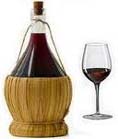Growing, Drying and Using Herbs
from Italian Traditional Food
All about herbs
Check out these great Italian ideas at Amazon for Italian food and kitchen ideas.
Herbs have a real use in the kitchen, but they must be treated with respect,
for many are strong and pungent in flavour. When using them, you should remember that they are an addition and
enhancement to a dish and as such should be used sparingly.
On the whole, herbs are not difficult to grow and
the advantage of having a herb bed is that they are ready for use fresh, or can be dried for later on. Choose a
spot for growing herbs that's near the kitchen door. If you haven't a garden, you'll find
herbs will thrive equally well in a window box.
Types of herbs
Of the many varieties of herbs the following are the most commonly used in the kitchen.
Bay
Together with parsley and thyme, a bayleaf forms the traditional bouquet garni. It has a strong
flavour, particularly when fresh, so unless recipes call for more, use only half a bayleaf to flavour soups, meat
dishes and sauces. The bay tree is very attractive and can be grown in the garden or in a tub.
Chives
This herb is a necessity for every garden and window box. A perennial herb that is used snipped
(with scissors) in salads, creamed cheeses or in stuffings when a subtle flavour of onion is called for.
Dill
This annual is by far the best to grow in preference to fennel. It is delicate in flavour, and
pretty and feathery in appearance. Dill is the herb to use with fish, either in a sauce or chopped and sprinkled
over it. It is more delicate and subtle in flavour than fennel and marries well with cucumber.
The stalks and seeds are used in pickles, especially cucumber, and the seeds only for flavouring
salads and vegetables, especially white cabbage and marrow.
Fennel
A tall and rampant perennial plant which produces more foliage than one can ever use. Strong in
taste, it must be used sparingly, eg. in fish sauces.
Garlic
A bulb similar to an onion but divided into sections called cloves. These are covered with a
fine skin which is removed before chopping, crushing or using them whole. For some dishes the "cloves" are left
unpeeled before cooking and taken out before serving (this gives a delicate flavour).
Garlic can be grown in a herb garden, though
the size of the gathered bulbs depends on the amount of sun and moisture during growth. In the early autumn garlic
bulbs are lifted and dried like onions.
Marjoram
This spicy aromatic herb is used principally for stuffings, especially for lamb. Though classed
as a half-hardy annual, it will grow for 2-3 years without dying off, and will seed itself under normal conditions.
When dried it mixes well with thyme and savory for use when recipes call for mixed herbs.
Mints
Many people are unaware that there are several varieties of this perennial herb. The mint that
is sold in the shops and grown in many gardens for kitchen use is spearmint. After a few years it is apt to revert
towards its wild state, ie. get coarse and harsh in flavour. For growing at home the Bowles variety of mint (Mentha
rotundifolia) is very satisfactory. It has large rather wooly leaves and is excellent for a mint sauce and general
flavouring.
Other mints are the scented ones: apple, pineapple and eau-de-cologne, the two latter being
especially good in a fruit or wine cup and for use as a tea. Apple mint is a good substitute for sage in a savoury
stuffing and for flavouring an apple jelly.
Parsley
The most usual and common herb of all is parsley, called in
earlier days the herb of health. Nowadays it has been relegated to a garnish,
which is a pity as it can be made into a good jelly (to eat on bread and butter) or a delicious soup.
Page 2 of this Italian Traditional Food article can be found on the next page.
Page 1 Next >>

Copyright © 2009 -
. All Rights Reserved Worldwide. Italian Traditional Food
You may not reprint articles from this website
without the written permission of the site owner.
Disclaimer: Articles on this
Website are provided for information purposes only. Italiantraditionalfood.com does not accept any responsibility
or liability for the use or misuse of the article content on this site or reliance by any person on the site's
contents.
| 


 Digg
Digg Stumbleupon
Stumbleupon Google Bookmarks
Google Bookmarks Delicious
Delicious Twitter
Twitter Facebook
Facebook Yahoo My Web
Yahoo My Web Reddit
Reddit